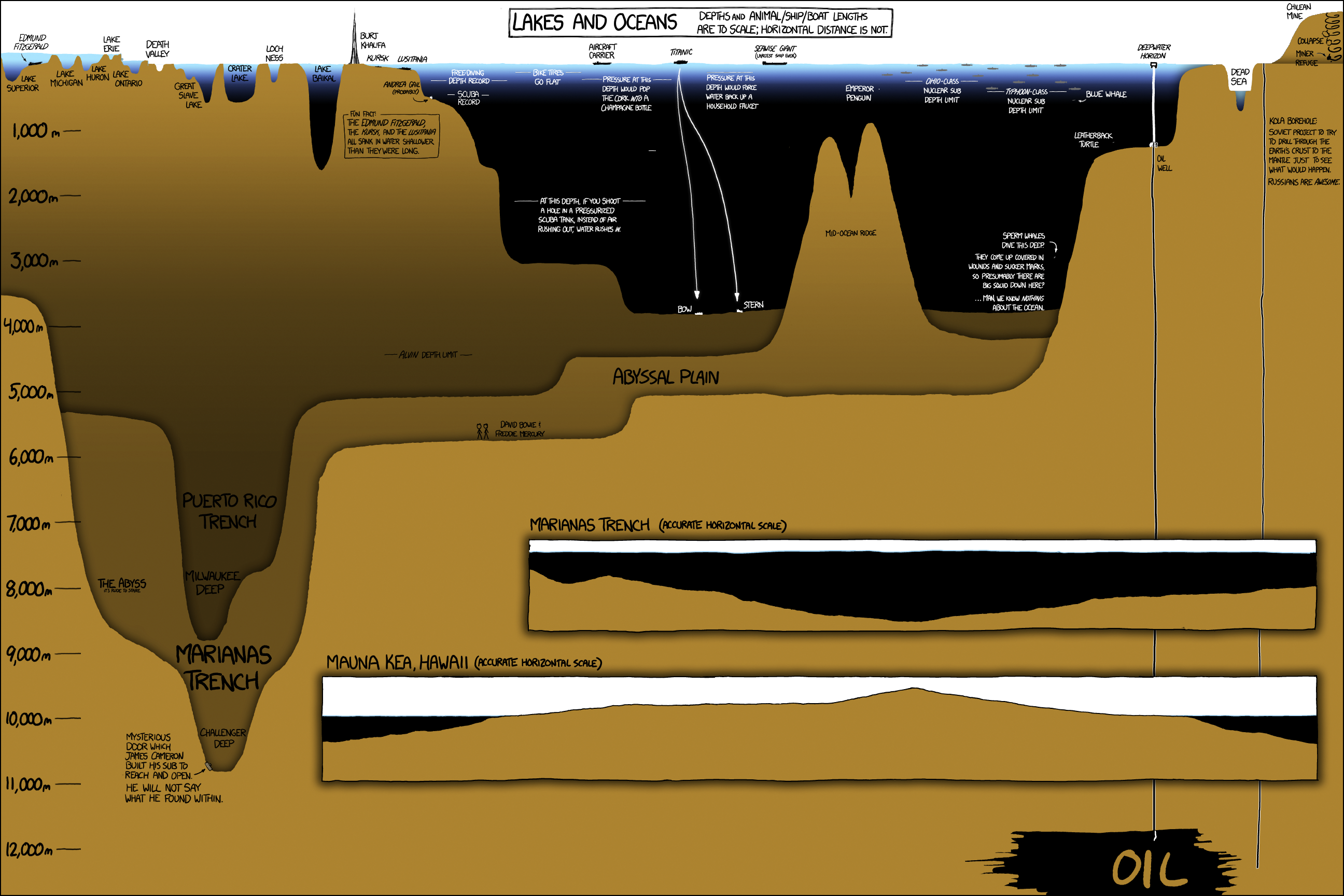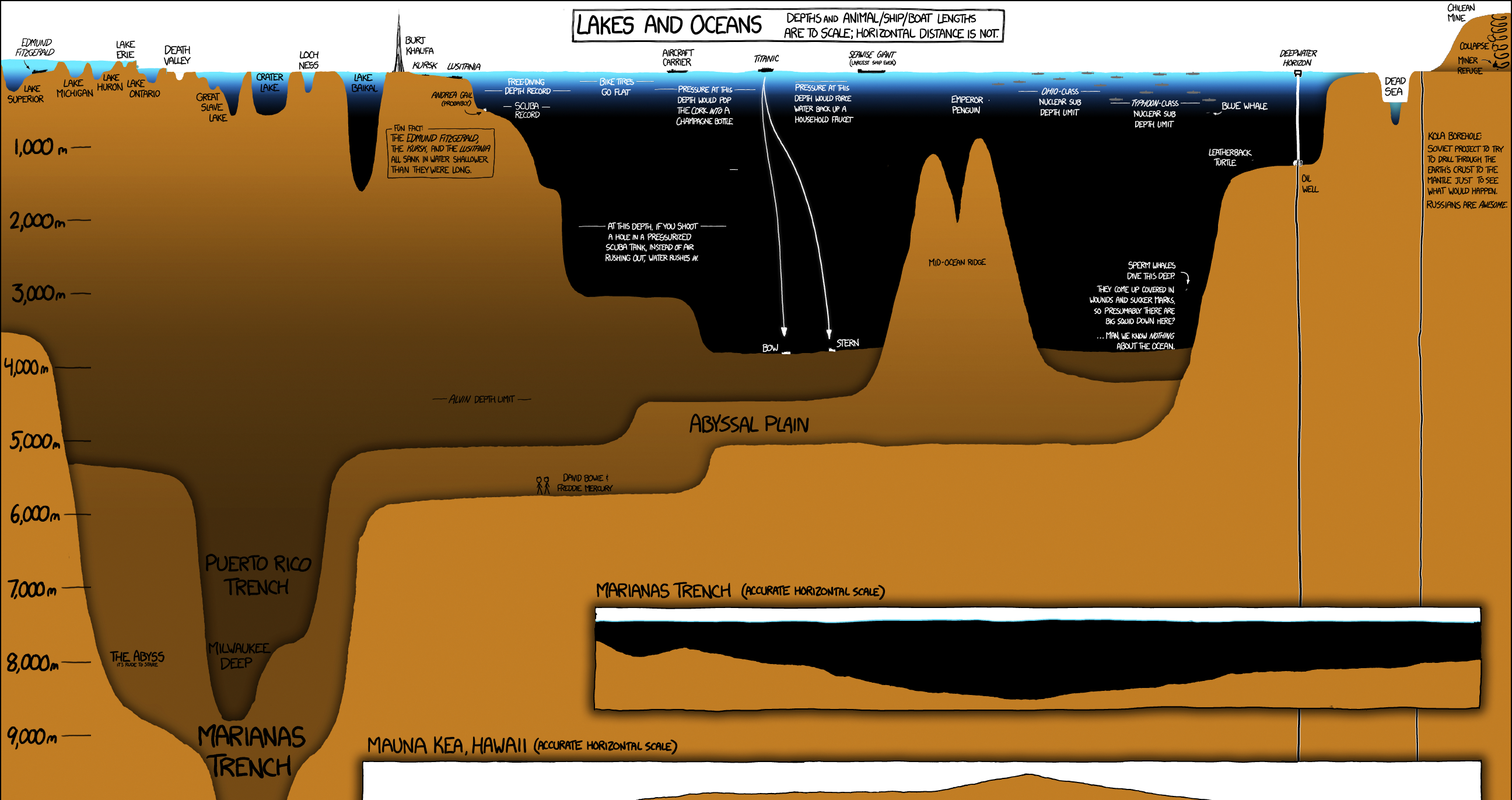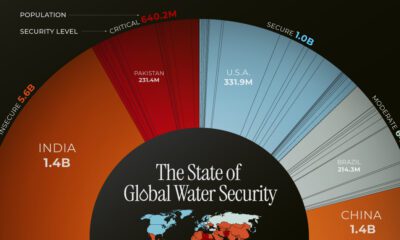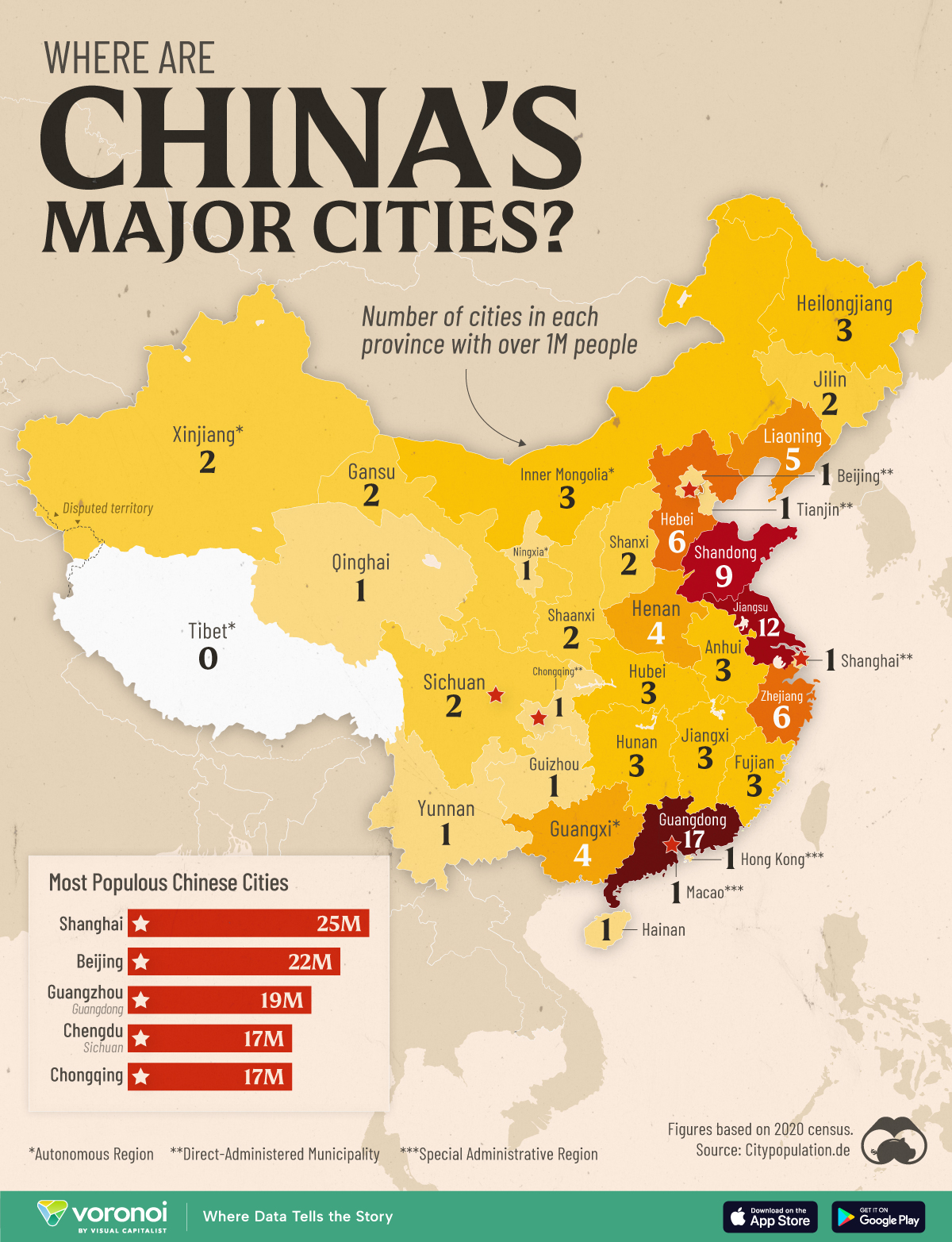Misc
A Deep Dive Into the World’s Oceans, Lakes, and Drill Holes
Explore the full-size version of this visualization by clicking here.
Credit: xkcd
Today’s chart is best viewed full-screen. Explore the high resolution version by clicking here.
Sailors have been circumnavigating the high seas for centuries now, but what could be found beneath the sunlit surface of the ocean remained a mystery until far more recently. In fact, it wasn’t until 1875, during the Challenger expedition, that humanity got it’s first concrete idea of how deep the ocean actually was.
Today’s graphic, another fantastic piece by xkcd, is a unique and entertaining look at everything from Lake Superior’s ice encrusted shoreline down to blackest, inhospitable trench (which today bears the name of the expedition that first discovered it).
The graphic is packed with detail, so we’ll only highlight a few points of interest.
Deep Thoughts with Lake Baikal
Deep in Siberia, abutting a mountainous stretch of the Mongolian border, is the one of the most remarkable bodies of water on Earth: Lake Baikal. There are a number of qualities that make Lake Baikal stand out.
Depth: Baikal, located in a massive continental rift, is the deepest lake in the world at 1,642m (5,387ft). That extreme depth holds a lot of fresh water. In fact, an estimated 22% of all the world’s fresh water can be found in the lake.
Age: Baikal (which is listed as a UNESCO World Heritage Site) is estimated to be over 25 million years old, making it the most ancient lake on the planet.
Clarity: Interestingly, the water in the lake is exceptionally clear. In winter, visibility can extend over 30m (98ft) below the surface.
Biodiversity: The unique ecosystem of Lake Baikal provides a home for thousands of plant and animal species. In fact, upwards of 80% of those species are endemic, meaning they are unique to that region.
Who is Alvin?
Since 1964, a hard-working research submersible named Alvin has been helping us better understand the deep ocean. Alvin explored the wreckage of RMS Titanic in 1986, and helped confirm the existence of black smokers (one of the weirdest ecosystems in the world).
Though most of the components of the vessel have been replaced and upgraded over the years, it’s still in use today. In 2020, Alvin received an $8 million upgrade, and is now capable of exploring 99% of the ocean floor.
We know more about the surface of Venus than the bottom of the ocean. The potential for discovery is huge.– Anna-Louise Reysenbach, Professor of Microbiology, PSU
The Ocean’s Deepest Point
The deepest point in the ocean is the Mariana Trench, at 11,034 meters (36,201 feet).
This trench is located in the Pacific Ocean, near Guam and the trench’s namesake, the Mariana Islands. While the trench is the most extreme example of ocean depths, when compared to surface level distance, it’s depth is shorter than Manhattan.
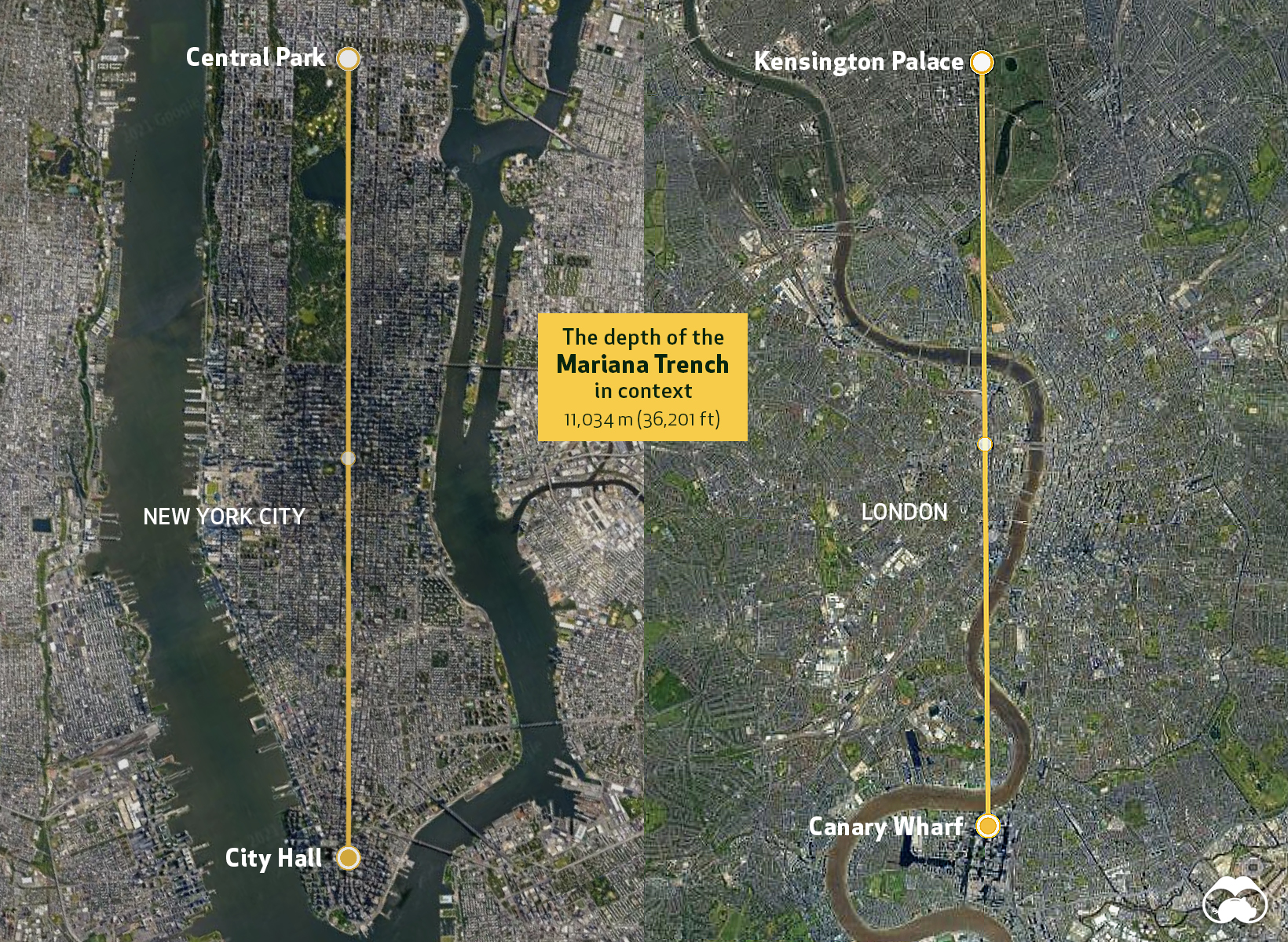
Obviously, the context of surface distance is wildly different than vertical distance, but it serves as a reminder of how narrow the “explorable” band of the Earth’s surface is.
Polymetallic Nodules
The ancient Greek word, ábyssos, roughly means “unfathomable, bottomless gulf”. While there is a bottom (the abyssopelagic zone comprises around 75% of the ocean floor), the enormous scale of this ecosystem is certainly unfathomable.
Objectively, the abyssal plain is not the prettiest part of the ocean. It’s nearly featureless, and lacks the panache of, say, a coral reef, but there are still some very compelling reasons we’re eager to explore it. Resource companies are chiefly interested in polymetallic nodules, which are essentially rich manganese formations scattered about on the sea bottom.
Manganese is already essential in steel production, but demand is also getting a substantial lift from the fast-growing electric vehicle market. The first company to find an economical way to harvest nodules from the ocean floor could reap a significant windfall.
Drill Baby, Drill
Demand for resources can force humans into some very inhospitable places, and in the case of Deepwater Horizon, we chased oil to a depth even surpassing the famed Marianas Trench.
Drilling that far below the surface is a complicated endeavor, and when the drill platform was put into service in 2001, it was hailed as an engineering marvel. To this day, Deepwater Horizon holds the record for the deepest offshore hole ever made.
After the rig’s infamous explosion and subsequent spill in 2010, that depth record for drilling may stand the test of time.
Maps
Mapped: Chinese Provinces With Cities Over 1 Million People
Some Chinese provinces are so populous they rival entire countries. But how many of them have cities over a million people?
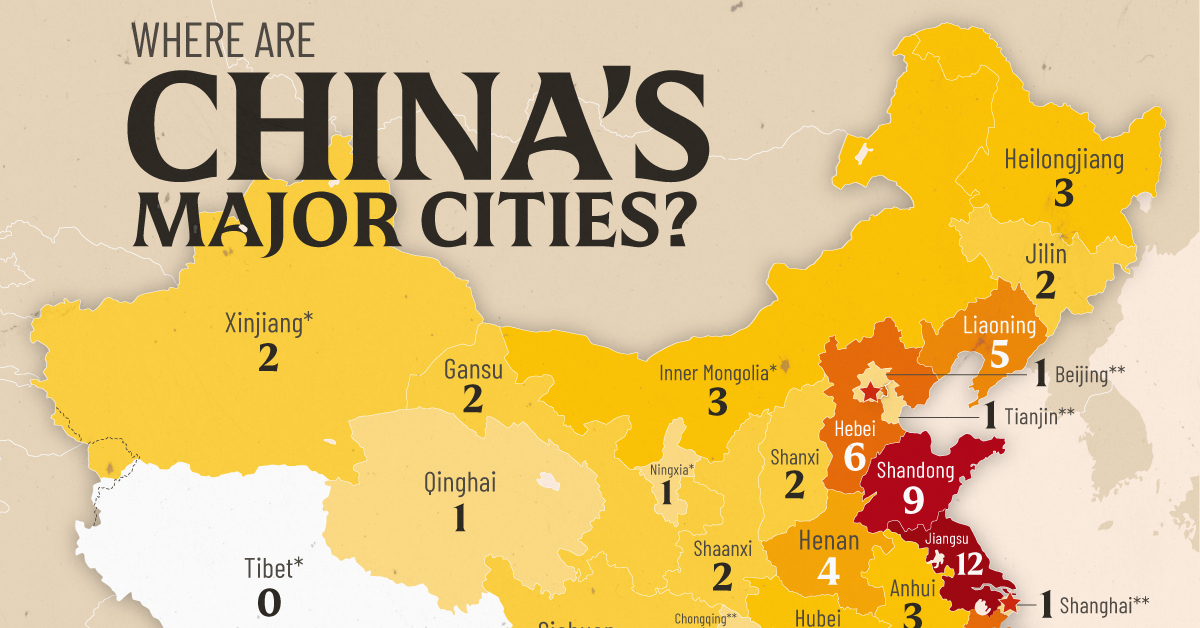
Mapped: Chinese Provinces With Cities Over 1 Million People
This was originally posted on our Voronoi app. Download the app for free on iOS or Android and discover incredible data-driven charts from a variety of trusted sources.
Almost two-thirds of the 1.4 billion Chinese population lives in an urban area. But how does this play out across the country’s geography?
This map shows the Chinese provinces with cities over a million residents. Data for this graphic is sourced from citypopulation.de.
Ranked: Chinese Provinces With Cities Over 1 Million People
China’s Guangdong province has 17 cities with a population size of 1 million or more. It is also China’s most populous province, home to 127 million people. This makes it comparable to the size of Japan, the 12th most populous country in the world.
| Rank | Province | Cities With 1 Million People |
|---|---|---|
| 1 | Guangdong | 17 |
| 2 | Jiangsu | 12 |
| 3 | Shandong | 9 |
| 4 | Hebei | 6 |
| 5 | Zhejiang | 6 |
| 6 | Liaoning | 5 |
| 7 | Guangxi* | 4 |
| 8 | Henan | 4 |
| 9 | Anhui | 3 |
| 10 | Fujian | 3 |
| 11 | Heilongjiang | 3 |
| 12 | Hubei | 3 |
| 13 | Hunan | 3 |
| 14 | Inner Mongolia* | 3 |
| 15 | Jiangxi | 3 |
| 16 | Jilin | 2 |
| 17 | Gansu | 2 |
| 18 | Shaanxi | 2 |
| 19 | Shanxi | 2 |
| 20 | Sichuan | 2 |
| 21 | Xinjiang* | 2 |
| 22 | Beijing** | 1 |
| 23 | Chongqing** | 1 |
| 24 | Guizhou | 1 |
| 25 | Hainan | 1 |
| 26 | Ningxia* | 1 |
| 27 | Qinghai | 1 |
| 28 | Shanghai** | 1 |
| 29 | Tianjin** | 1 |
| 30 | Yunnan | 1 |
| 31 | Hong Kong*** | 1 |
| 32 | Macao*** | 1 |
*Autonomous Region. **Direct-Administered Municipality. ***Special Administrative Region.
Jiangsu, ranked fourth in population overall, is the only other province which has 10+ cities with a million or more inhabitants.
Meanwhile, some of China’s most populous cities—Shanghai, Beijing, Tianjin, and Chongqing—are administered directly by the central government, and do not fall under provincial control.
In fact, Shanghai and Beijing have informal “population caps” to prevent them from growing larger, in a bid to reduce pollution, overcrowding, and pressure on public services.
On the other hand, Tibet’s cold climes and rugged terrain make for a sparsely-populated area, totalling 3 million people across 1.2 million km². Tibet is the only province-level division in China without a single city over a million residents.
All together, China has 105 cities with more than one million inhabitants. For comparison, India has 65, and the U.S. has nine.
Learn More About Population Metrics from Visual Capitalist
If you enjoyed this post, check out Interactive Map: The World as 1,000 People. This visualization shows how unevenly people are distributed across the globe, re-imagining the entire 8 billion human population as only 1,000 people.
-
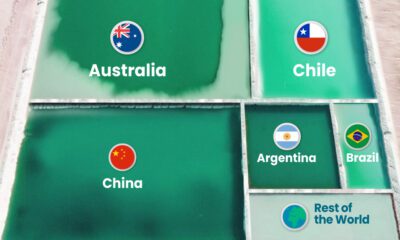
 Energy1 week ago
Energy1 week agoRanked: The World’s Largest Lithium Producers in 2023
-

 Public Opinion2 weeks ago
Public Opinion2 weeks agoCharted: How Democrats and Republicans View Government Agencies
-

 Globalization2 weeks ago
Globalization2 weeks agoMapped: The Top Exports in Asian Countries
-

 Finance2 weeks ago
Finance2 weeks agoRanked: The World’s 50 Largest Private Equity Firms
-

 United States2 weeks ago
United States2 weeks agoMapped: The 10 U.S. States With the Lowest Real GDP Growth
-

 China2 weeks ago
China2 weeks agoComparing New and Current U.S. Tariffs on Chinese Imports
-

 Politics2 weeks ago
Politics2 weeks agoWhich Countries Have the Most Economic Influence in Southeast Asia?
-

 population2 weeks ago
population2 weeks agoThe Top 25 Nationalities of U.S. Immigrants

